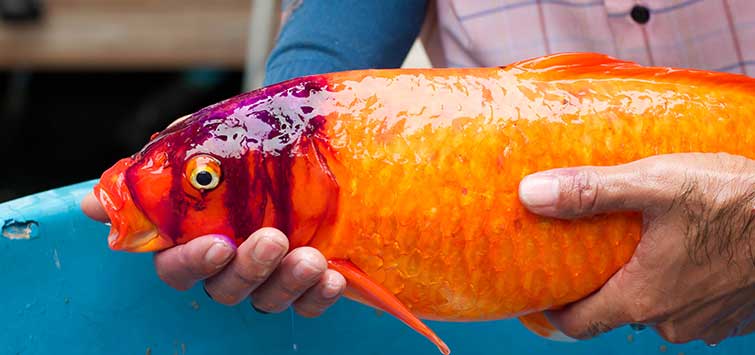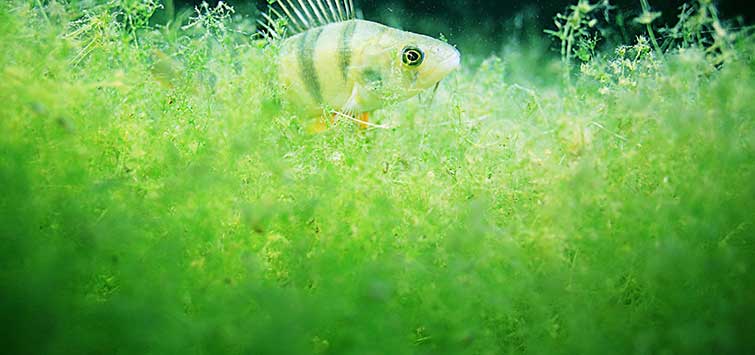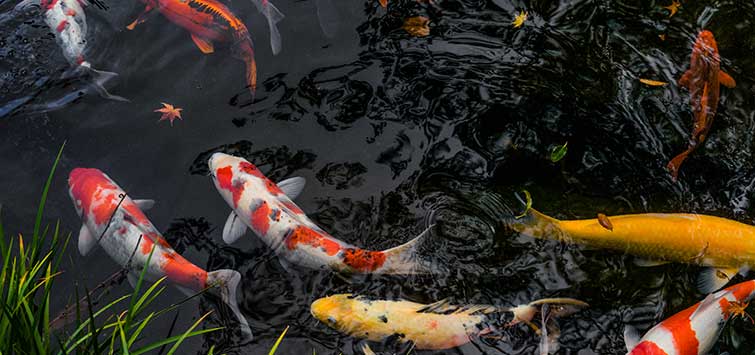Proper Antibiotic Use in Ornamental Fish
Author: Craig Adams, MS, DVM
Antibiotics can help save the lives of some of our favorite pet fishes, but these powerful medicines must be used correctly to be safe and effective.
Markie’s Story
As the day dawned, I was crossing Puget Sound on a Washington State ferry. The sun was just peeking over the Cascade Mountains as we docked. I was headed to the home of a pond owner who had called the day before with news that one of his prized kohakus had recently developed protruding eyes (exophthalmia). He was hoping that something could be done to try and save “Markie” (this is the fish’s real name; it has not been changed to protect his identity). Upon arriving, I could see that this was a very dedicated hobbyist. Markie was about 20 years old and had been given to the owner as a young tategoi many years previously. Markie was a veteran of many shows, and a winner of several. He was happily swimming with 21 of his closest friends—some even older than him. The exophthalmia was very subtle, and I knew that this was an owner who paid close attention to his charges.
Testing the Water
After admiring the pond and garden, I first collected a beaker of water from the pond and began to analyze it. The results surprised me. The ammonia was zero, the nitrite was zero, the nitrate was zero, and the sodium chloride was 1.3 parts per thousand.
The salt and nitrate readings puzzled me a bit. Often koi owners will add about 3 to 5 ppt sodium chloride to their ponds. Also, in a pond with a functioning biofilter, we expect to see some nitrate, as the nitrite is converted to nitrate during the nitrogen cycle. When I asked the owner about his maintenance routine, it became very clear. It seems that this owner has an artesian spring on his property and every other day he flushes his system with fresh water from the spring. He had given a salt bath the day before and was currently diluting it with the spring water. That explained both the lower-than-expected salt level and the lack of nitrate.
Making a Diagnosis
When we caught Markie the kohaku, we moved him to the owner’s 100-gallon stock tank, which he uses for quarantine and as a hospital tank for sick fish. Markie did have mild exophthalmia and some prominent vessels in his fins. I was suspicious that he may have septicemia (bacterial infection in the blood). Often in the spring and fall, especially in western Washington, the temperatures can fluctuate wildly. Koi can handle very cold water and very warm water, but only if they are acclimated slowly. In the spring and fall the daily variation can stress koi. This in turn can increase cortisol levels in the blood and cause a reduction in immunity. I took a sample for blood culture and sent it to the laboratory. We cultured Pseudomonas fluorescens. Once I had this information, we were able to treat Markie appropriately and successfully.
Treating Bacterial Infections
This was a bacterial infection, and we documented it. Many hobbyists will purchase various antibiotics—often packaged and sold inappropriately—and treat their system without a diagnosis. In the best of circumstances, they happen to randomly choose the proper drug for the condition and are successful. Many times the hobbyist is not actually dealing with a bacterial infection, and the antibiotics just kill the bacteria in their filter. Antibiotics can also, unfortunately, lead to resistant bacteria in their system. You do not want your fish to become infected with resistant bacteria.
Resistant strains of bacteria can be produced with indiscriminate use of antibiotics. This is generally not caused by a mysterious property of the drug that leads to genetic mutations, like you might see in a low-budget horror movie. The antibiotic is not itself causing mutations that lead to resistance. It is just killing the bacteria that are susceptible. Since no antibiotic kills all bacteria, some will survive. The survivors are able to reproduce in the absence of the ones that were killed. Now, there is a full population of bacteria that are not killed by that antibiotic. If this is done enough times with enough different antibiotics, a population of bacteria resistant to multiple antibiotics can be the result.
Choosing Antibiotics
Many variables are considered when choosing antibiotics. The first is whether or not a given antibiotic will kill the organisms causing the infection. We can make educated guesses in most cases, but sooner or later it’s the wrong choice. That is why it is critical to culture infections and also get antibiotic sensitivity data. Table 1 shows an example of culture and sensitivity results from two fish that I recently examined. They are both koi owned by different hobbyists.
Fish A
Fish A is a five-year-old platinum ogon koi that became inappetant and developed dropsy (ascites and tissue edema). Following my physical examination, I suspected septicemia and performed a blood culture. Three organisms (Aeromonas hydrophila, A. sobria, and P. fluorescens) were grown from the blood of fish A.
Fish B
Fish B is a six-year-old sanke koi that lives in the owner’s home office in a large aquarium next to his desk. He is affectionately known as “Phil,” and he lives with his best friend, a kohaku named “Roger.” (I always enjoy some of the human names that people pick for their pets.) Phil had developed a skin ulcer on his right operculum that was about 5 cm in diameter. I cultured two organisms from under the margin of the ulcer (A. hydrophila and P. fluorescens). The numbers on the chart represent the minimum inhibitory concentration (MIC) for the bacteria in a given antibiotic listed in the left column.
The MIC is established by trying to culture the bacteria in various concentrations of an antibiotic. If there is no growth (inhibition) in a concentration of antibiotic that is achievable in the infected tissue, the organism is considered sensitive to that antibiotic. That antibiotic should be effective. If the bacteria grow in high concentrations of the antibiotic, there is no inhibition and the bacteria are considered resistant to that particular antibiotic. The MIC tells us what tissue concentrations are needed to kill a particular organism.
Findings
As you can see, enrofloxacin would be a good choice for fish A; all three of the bacteria are sensitive to it. Florfenicol, another antibiotic that I often use, would not have been a good choice for fish A. But, I cannot then say from one culture report that enrofloxacin is always a good choice for fish with septicemia, or even fish with septicemia from these particular organisms. Fish B was infected with two of the same bacteria that fish A was infected with, but florfenicol is a better choice for fish B due to enrofloxacin resistance. Remember, both of these are still very good antibiotics when used appropriately.
Pharmacokinetics
Once we have chosen an antibiotic that is effective in killing the bacteria causing the infection, we must consider if the antibiotic will reach therapeutic concentrations in the infected tissues. This may seem nit-picky, but just pouring antibiotics into an aquarium does not mean that it will accumulate in appropriate concentrations where the infection is located. If the infection is in the kidney, will antibiotics in the water make it to the kidneys? The properties of drugs and their respective achievable tissue concentrations are the drug’s pharmacokinetics. Different routes of administration (i.e. oral, injectable, bath, etc.) will also potentially alter tissue concentrations.
We have a very good understanding of pharmacokinetics in people, dogs and cats, and agricultural animals. This is driven by economics and public health. We cannot assume, however, that the information carries from one species to the next, even if they are closely related like dogs and cats (dogs and cats are both members of the same order, Carnivora, while fish like characins and catfish, for example, are in different orders).
Information About Fish
What this means is that there are no pharmacokinetic parameters available for 99.9 percent of the fish kept in aquariums. We do have the information for food fish, again, for economic and public health reasons. But there are very few food-fish species grown in the United States. These are primarily channel catfish Ictalurus punctatus, salmonids Oncorhynchus and Salmo spp., and tilapia (mostly Oreochromis and Tilapia spp.).
Worldwide, carp (Cyprinus spp.) are the most important fin fish produced in aquaculture. As far as ornamental fish go, Dr. Greg Lewbart and his colleagues at the North Carolina College of Veterinary Medicine have performed a fair bit of work on the pharmacokinetics of antibiotics in red pacu Piaractus brachypomus and other species. From these few species, we can infer the pharmacokinetic information for silurids (channel catfish), cichlids (tilapia), cyprinids (carp), and characins (pacu). This covers most of the popular freshwater species kept by aquarists. Many other species, especially marine fish, really require educated guesses.
Legal Concerns
There are then some legal considerations. Food fish cannot be treated in an extra-label manner. Even if I cultured a bacterium sensitive to enrofloxacin from a channel catfish, I could not legally use it. Only three antibiotics are approved for use in food fish in the United States: Oxytetracycline, sulfadimethoxine/ormetoprim, and florfenicol, and then only in a well-defined manner. In non-food fish, such as the ornamental species we all keep and propagate, we can use medication in an extra-label manner with the caveat that the fish never enter the human food chain and that there is a valid veterinarian-client-patient relationship with appropriate record keeping.
Find a Vet
Even if you are not a koi hobbyist, these principles still apply. I have not only used them for recent cases with koi, but also with other patients such as a seahorse with a sloughing lesion on the skin, and a betta with buoyancy problems. So instead of guessing about appropriate treatments for sick fish, try to find a veterinarian in your area. Try www.aquavets.com, or ask your regular veterinarian—he or she may treat fish themselves.
A Note on Water Quality
As you read through the pages of TFH you will notice that water quality and filtration are discussed in every issue. If you are a frequent reader, it may even seem to get monotonous to read about the nitrogen cycle again and again. But this important concept is so fundamental and so poorly understood by the vast majority of fish owners that we sometimes need frequent repetition to help solidify it in our minds. If reading about it seems boring to you, you are likely in the top 25 percent or so of fishkeepers out there who do understand it, and you are doing what you can to keep your fish healthy. We should not strive to merely keep our fish alive, however—they should also thrive. Of course, this is preaching to the choir for most readers of TFH.
While a 20-year-old fish may sound old (and it is if you are a guppy or a killifish), it is fairly young for a well-kept koi. It has been said that the oldest known koi was owned by the emperor of Japan and was documented to be over 200 years old. Even if a well-meaning servant secretly replaced it sometime along the way, it can be agreed that it/they lived an extremely long time. Have you even wondered how many koi at garden centers or pet stores even live to be 10 years old? If you haven’t, I can tell you that not very many of them do. The lucky ones have owners who understand the nitrogen cycle.

.png?h=595&iar=0&w=2781&hash=5FD5E69473BCC22199FBFA2FB71B6033)



